Raabe J. Hydro power - the design, use, and function of hydromechanical, hydraulic, and electrical еquipment
Подождите немного. Документ загружается.

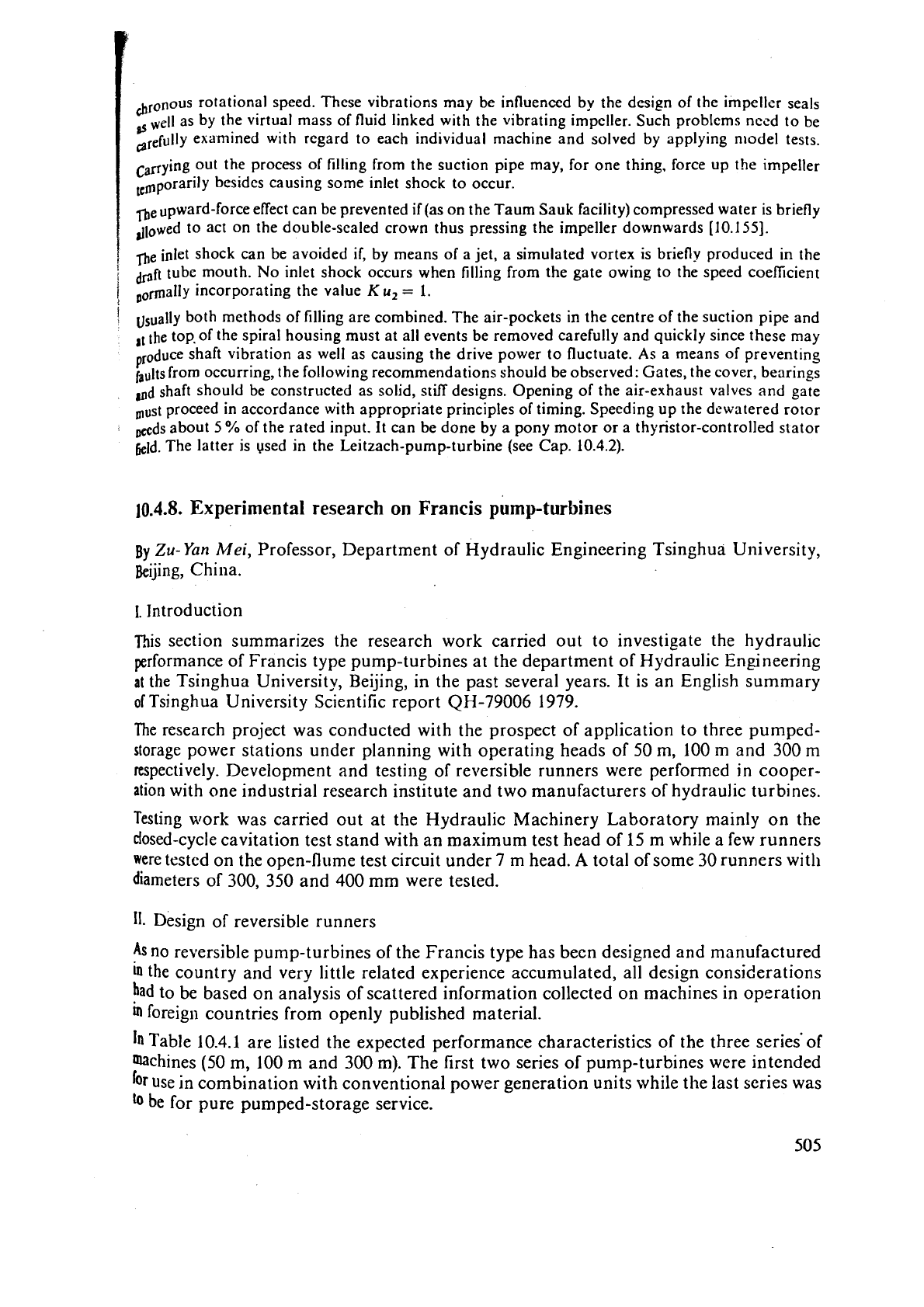
nous rotational speed. Thcse vibrations may be influenced by the design of the impeller seals
*:ell
as by the virtual mass of fluid linked with the vibrating impeller. Such problems need to be
'
,fully examined with regard to each individual machine and solved by applying nlodel tests.
I
Carrying out the process of filling from the suction pipe may, for one thing. force up the impeller
tclllporarily besides causing some inlet shock to occur.
fie
upward-force effect can be prevented if (as on the Taum Sauk facility) compressed water
is
briefly
dlowed to act on the double-sealed crown thus pressing the impeller downwards [10.155].
fie inlet shock can be avoided if, by means of a jet, a simulated vortex is briefly produced in the
@fi
tube mouth. No inlet shock occurs when filling from the gate owing to the speed coefficient
I
ally
incorporating the value
K
u,
=
1.
!
usually both methods of filling are combined. The air-pockets in the centre of the suction pipe and
,t
the top. of the spiral housing must at all events be removed carefully and quickly since these may
shaft vibration as well as causing the drive power to fluctuate. As a means of preventing
faults from occurring, the following recommendations should be observed: Gates, the cover, bearings
shaft should be constructed as solid, stiff designs. Opening of the air-exhaust valves and gate
must proceed in accordance with appropriate principles of timing. Speeding up the dewatered rotor
peeds about
5
%
of the rated input. It can be done by
a
pony motor or a thyristor-controlled stator
bid.
The latter is vsed in the Leitzach-pump-turbine (see Cap. 10.4.2).
10.4.8.
Experimental research
on
Francis p"rnyturbines
By
Zu-
Yan
Mei,
Professor, Department of Hydraulic Engineering Tsinghua University,
Beijing, China.
I.
Introduction
nis section summarizes the research work carried out to investigate the hydraulic
performance of Francis type pump-turbines at the department of Hydraulic Engineering
at
the Tsinghua University, Beijing, in the past several years. It is an English summary
of
Tsinghua University Scientific report QH-79006 1979.
The research project was conducted with the prospect of application to three
pumped-
storage power stations under planning with operating heads of 50 m, 100 m and 300 m
respectively. Development and testing of reversible runners were performed in cooper-
ation with one industrial research institute and two manufacturers of hydraulic turbines.
Testing work was carried out at the Hydraulic Machinery Laboratory mainly on the
dosed-cycle cavitation test stand with an maximum test head of 15 m while a few runners
were testcd on the open-flume test circuit under 7 m head.
A
total of some 30 runners wit11
diameters of 300, 350 and 400 mm were tested.
11.
Design of reversible runners
AS
no reversible pump-turbines of the Francis type has been designed and manufactured
in
the country and very little related experience accumulated, all design considerations
ration
bad
to be based on analysis of scattered information collected on machines in op-
m
foreign countries from openly published material.
In
Table 10.4.1 are listed the expected performance characteristics of the three series'of
machines (50 m, 100 m and 300 m). The first two series of pump-turbines were intended
for
use
in
combination with conventional power generation units while the last series was
10
be
for pure pumped-storage service.
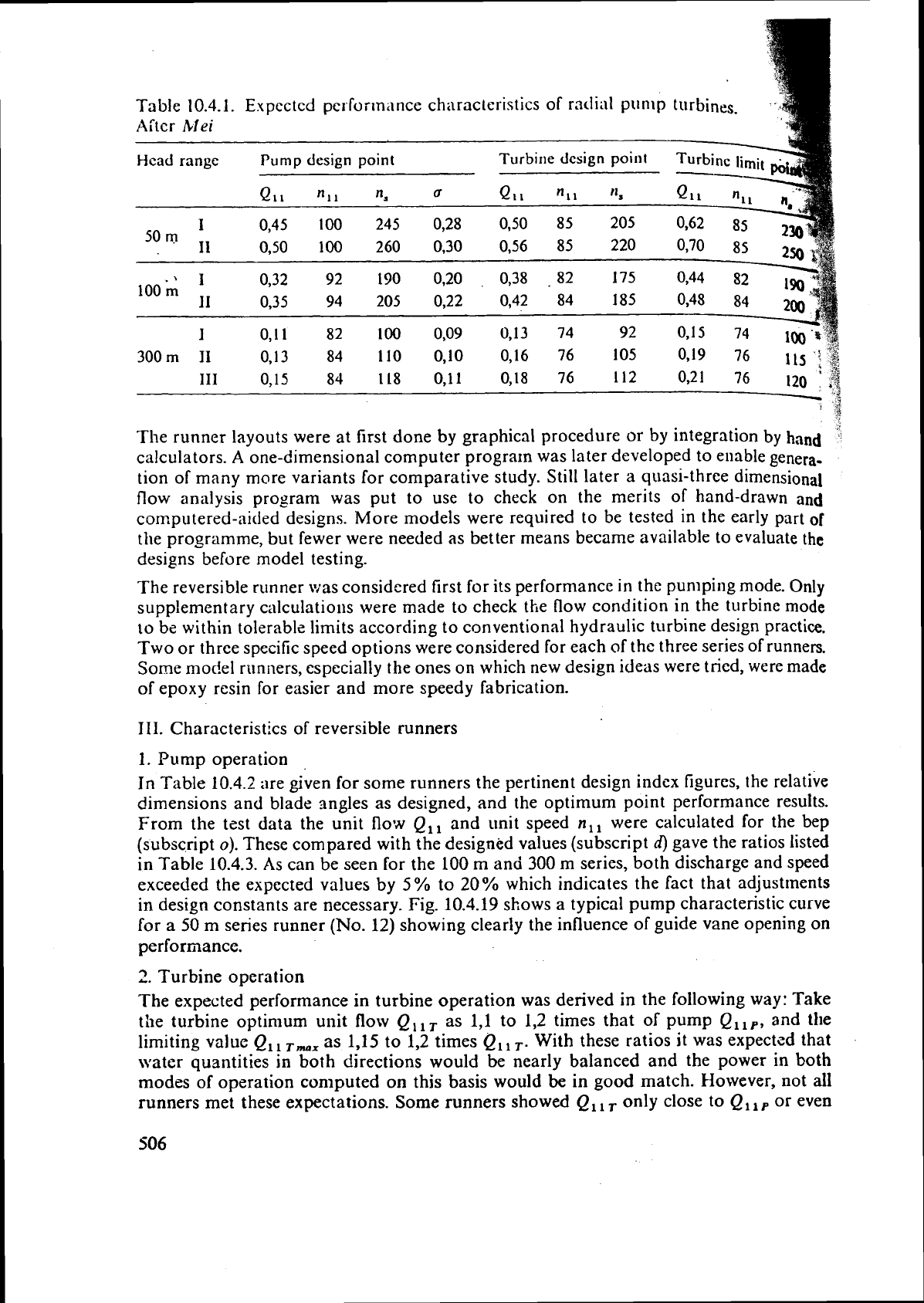
Table
10.4.1.
Expectcd petfonn,ince characieristics of radial pump tt1rbines.
ACtcr
Mei
Hcad range
Pump
design point
Turbirle
design
point
The runner layouts were at first done by graphical procedure or by integration by hand
calculators.
A
one-dimensional computer program was later developed to enable genera-
tion of many more variants for comparative study. Still later a quasi-three
dimensional
flow analysis program was put to use to check on the merits of hand-drawn
and
computered-aided designs. More models were required to be tested in the early part
of
the programme, but fewer were needed as better means became available to evaluate
the
designs before model testing.
The reversible runner
was considered first for its performance in the punlping mode. Only
supplementary
calculatiolls were made to check the flow condition in the turbine mode
to be within tolerable limits according to conventional hydraulic turbine design practice.
Two or three specific speed options were considered for each
of
the three series of runners.
Some model runners, especially the ones on which new design ideas were tried, were made
of
epoxy resin for easier and more speedy fabrication.
111.
Characteristics of reversible runners
1. Pump operation
In Table 10.4.2 are given for some runners the pertinent design index figures, the relative
dimensions and blade
sngles as designed, and the optimum point performance results.
From the
tzst data the unit flow Q,, and unit speed
n,,
were calculated for the bep
(subscript
0).
These compared with the designed values (subscript
d)
gave the ratios listed
in Table 10.4.3. As can be seen for the 100
m
and 300
m
series, both discharge and speed
exceeded the expected values by
5
%
to 20
%
which indicates the fact that adjusttnents
in
design constants are necessary. Fig. 10.4.19 shows a typical pump characteristic curve
for a 50 m series runner (No. 12) showing clearly the influence of guide vane opening on
performance.
2.
Turbine operation
The expected performance in turbine operation was derived in the following way: Take
the turbine optimum unit flow Q,,
,
as 1,l to 1,2 times that of pump Q,,
,,
and
tlie
limiting value
Q,!
,,,
as
1,15
to 1,2 times
Q,,
,.
With these ratios it was expectsd that
water quantities xn both directions would be nearly balanced and the power in both
modes of operation
computed on this basis would
be
in good match. However, not all
runners met these expectations. Some runners showed Q,
,
,
only close to Q
,
,
,
or
even
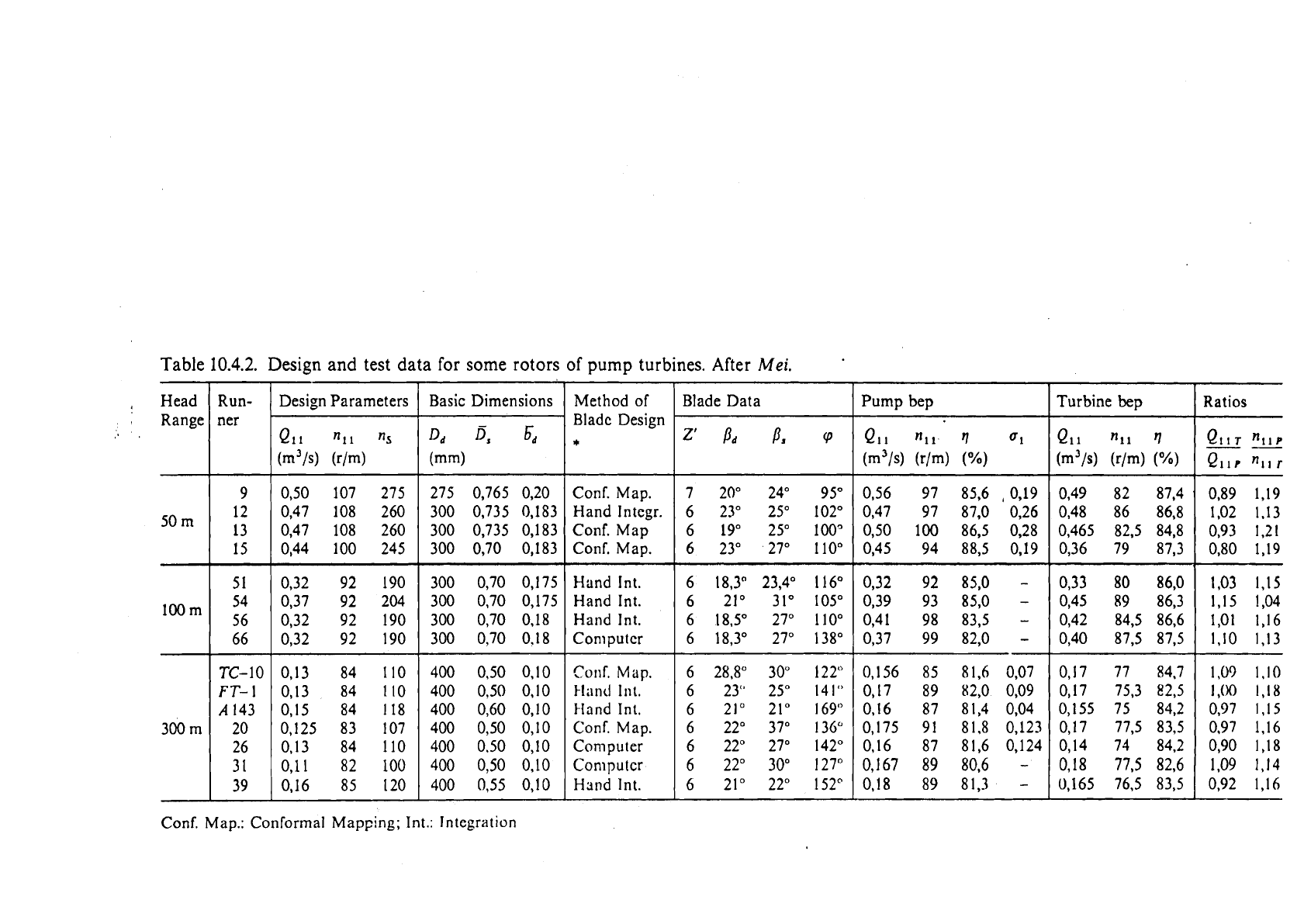
Table
10.4.2.
Design and test data for some rotors of
pump
turbines. After
Mei.
Conf. Map.: Conformal Mapping; Int.: Integration
Head
Range
50
I*
300
m
Run-
ner
9
12
13
15
51
54
56
66
TC-10
FT-
1
A143
20
26
31
39
Design Parameters
Q11 n11
ns
(m31s) (r~m)
0,50 107
275
0,47 108 260
0,47 108
260
0,44 100
245
0,32
92 190
0,37
92 204
0,32
92 190
0,32
92 190
0,13 84 110
0,13 84 110
0,15 84 118
0,125 83 107
0,13 84 110
O,11 82 100
0,16 85 120
Method of
Bladc Design
,
Conf. Map.
Hand
lntcgr.
Canf, Map
Conf. Map.
Hand Int.
Hand Int.
Hand
Int.
Conlputcr
Conf.Map.
l-lnnd
Int.
Hand Int.
Conf. Map.
Conlputer
Conlputcr
Hsnd
Int.
Basic Dimensions
Dd
Ds
Ed
(mm)
275
0,765
0,20
300 0,735 0,183
300 0,735 0,183
300
0,70
0,183
300
0,70 0,175
300 0.70
0,175
300 0.70
0,18
300 0.70
0.18
400
0.50 0,10
400
0.50 0,10
400 0,60
0,10
400 0,50 0,10
400
0.50
0,10
400 0,50
0,10
400
0,55 0,10
Blade Data
2'
Pd
8,
v
7 20" 24" 95"
6 23"
25" 102"
6
19'
25" 100'
6 23"
27" 110"
6
18,3"
23,4" 116"
6 21"
31"
105"
6 18,5"
27" 110"
6 18,3"
27" 138"
6 28,8"
30" 122"
6 23"
25" 141"
6 21"
21" 169"
6 22"
37" 136"
6 22"
27" 142"
6
22"
30"
127"
6 21"
22" 152"
Pump bep
Q11
~II
B
01
(m31s) (r~m)
(%I
0.56
97
85,6
,
0,19
0,47 97
87,O 0,26
0,50 100
86,5 0.28
0,45
94
88,5 0,19
0,32 92 85,O
-
0,39 93 85,O
-
0,41 98
83,5
-
0,37 99 82,O
-
0,156
85
81,6
0,07
0,17 89 82,O 0,09
0,16 87 81,4 0.04
0,175 91
81.8 0,123
0,16 87 81,6 0,124
0,167
89
80,6
-
0,18 89
81,3
-
Turbine bep
Ql1 "11
B
(m31s) (r~m)
(%I
0,49 82
87,4
0,48 86
863
0,465 82,5
84.8
0,36 79
87.3
0.33
80
86,O
0,45 89
86,3
0,42
84,5 86,6
0,40 87,5
87,5
0,17
77 84,7
0,17 75,3
82,5
0,155 75
84,2
0,17 773
833
0,14 73 84.2
0,18
77,5
82,6
0,165 76,5
83,5
Ratios
Qll~
~IIP
--
Q~~
P
rill
r
0,89 1,19
1,02 1,13
0.93 1,21
0,80 1,19
1,03
1,15
1,15 1,04
1,Ol l,I6
1.10 1,13
1,09 1.10
I,oO 1,18
0,97 1,15
0,97 1.16
0,90 1,18
1.09 1,14
0,92 1,16
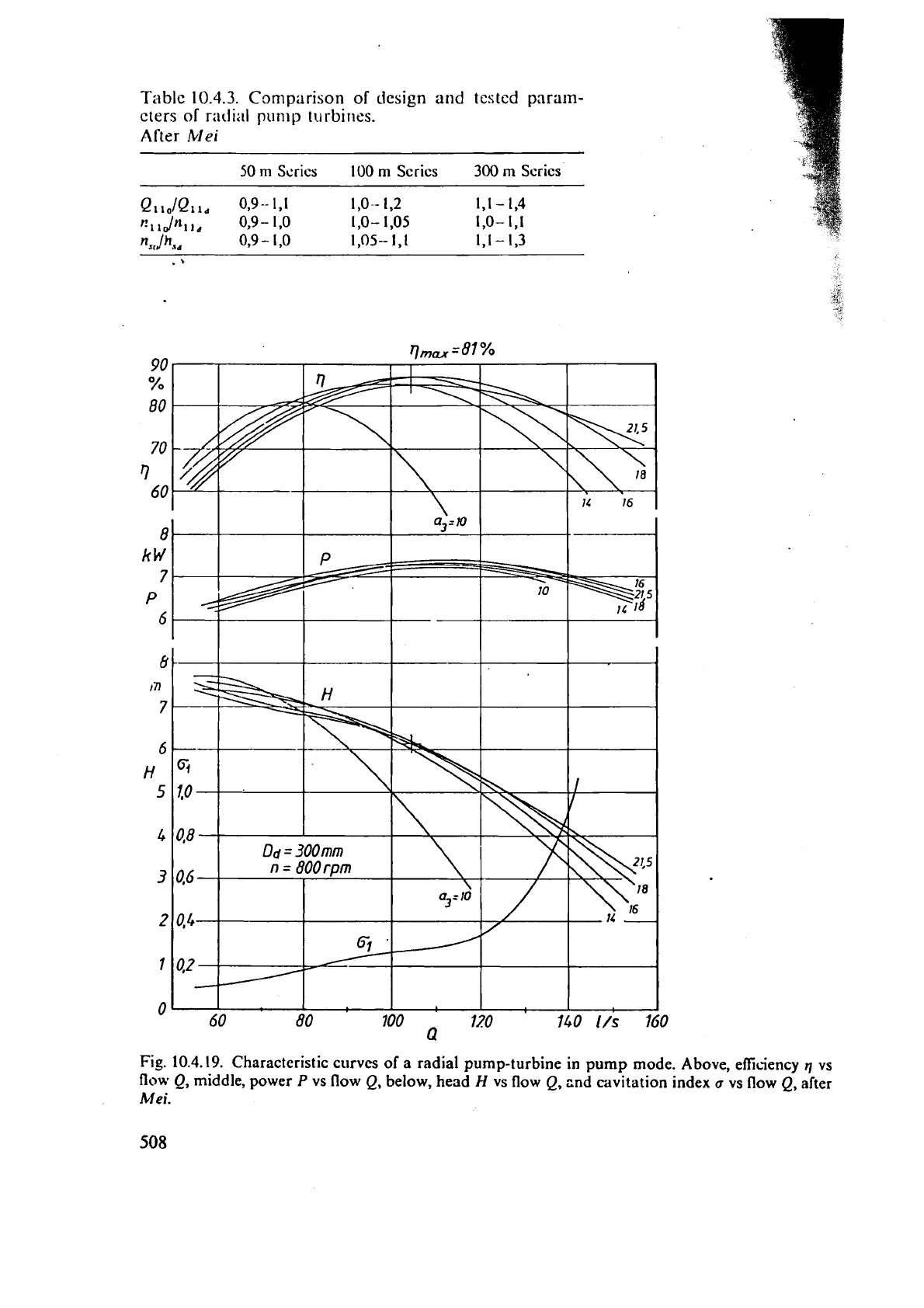
Table
10.4.3.
Comparison of
design
and tested
param-
cters
of
ratliiil
pump
turbines.
After
hlei
50
m
Scrics 100
rn
Series
300
m
Scrics
Fig.
10.4.19. Characteristic curves of
a
radial pump-turbine in pump mode. Above, efficiency
q
vs
flow
Q,
middle, power
P
vs
flow
Q, below, head
H
vs flow Q,
cnd
cavitation index
o
vs flow Q, after
Mei.
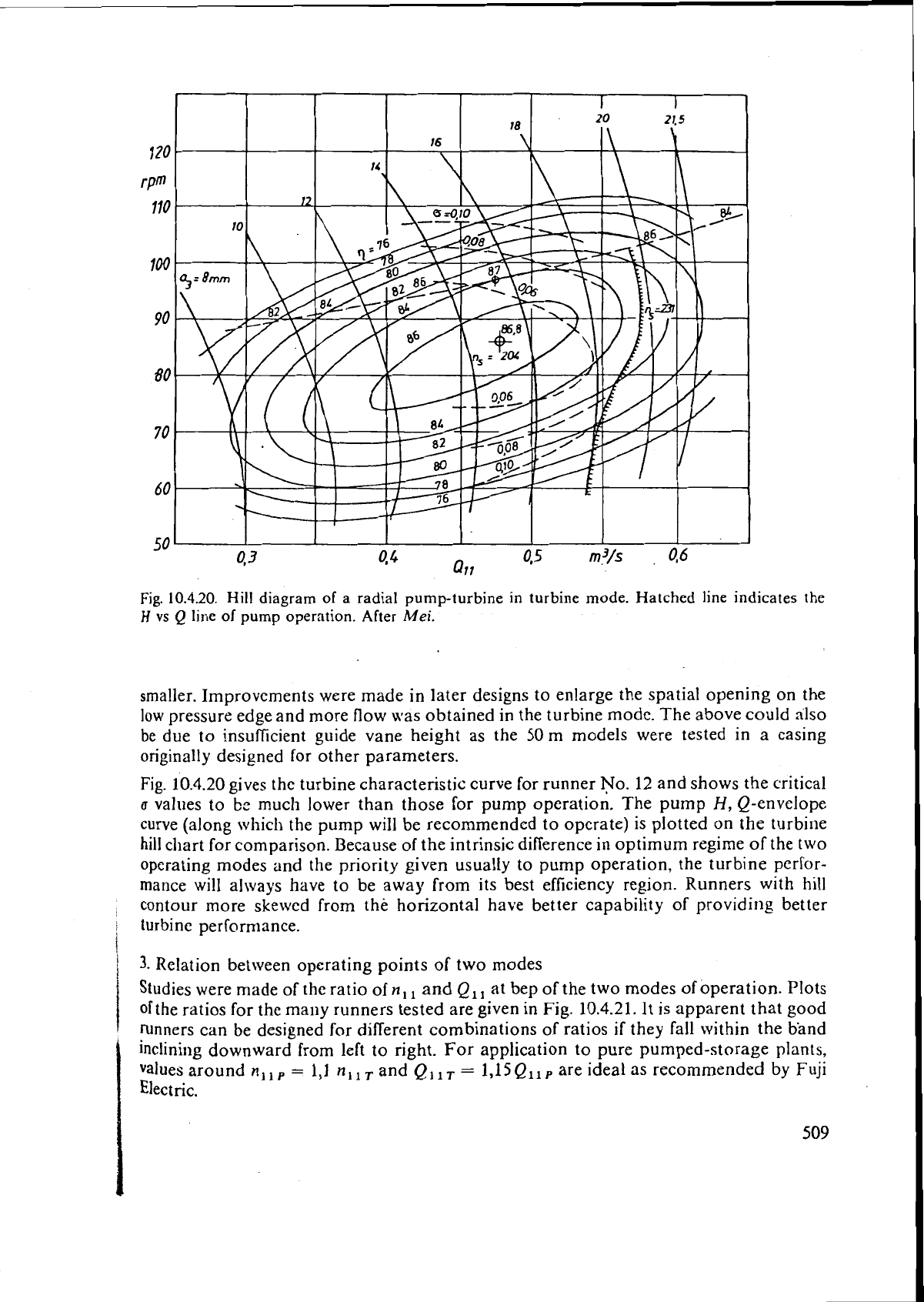
Fig.
10.4.20.
Hill diagram of
a
radial pump-turbine in turbine mode. Hatched line indicates the
H
vs
Q
line of pump operation. After
Mei.
smaller. Improvements were made in later designs to enlarge the spatial opening on the
low pressure edge and more flow was obtained in the turbine mode. The above could also
be
due to insufficient guide vane height as the 50 m models were tested in a casing
originally designed for other parameters.
Fig. 10.4.20 gives the turbine characteristic curve for runner No.
12
and shows the critical
o
values to
be
much lower than those for pump operation. The pump
H,
Q-envelope
curve (along
which
the
pump will be recommended to operate) is plotted on
the
turbine
hill
chart for comparison. Because of the intrinsic difference in optimum regime
of
the two
operating modes and the priority given usually to pump operation, the turbine perfor-
mance will always have to be away from its best efficiency region. Runners with hill
contour more
skewcd from the horizontal have better capability of providing better
turbine performance.
3.
Relation between operating points of two modes
Studies were made of the ratio of
n,,
and Q,, at bep of the two modes of operation. Plots
of
the ratios for the many runners tested are given in Fig. 10.4.21.
It
is apparent that good
runners can be designed for different combinations of ratios if they fall within the
band
inclining downward from left to right. For application to pure pumped-storage plants,
values around
n,,
,
=
1,l
n,,
and Q,,
=
1,15Ql,,, are ideal as recommended by Fuji
Electric.
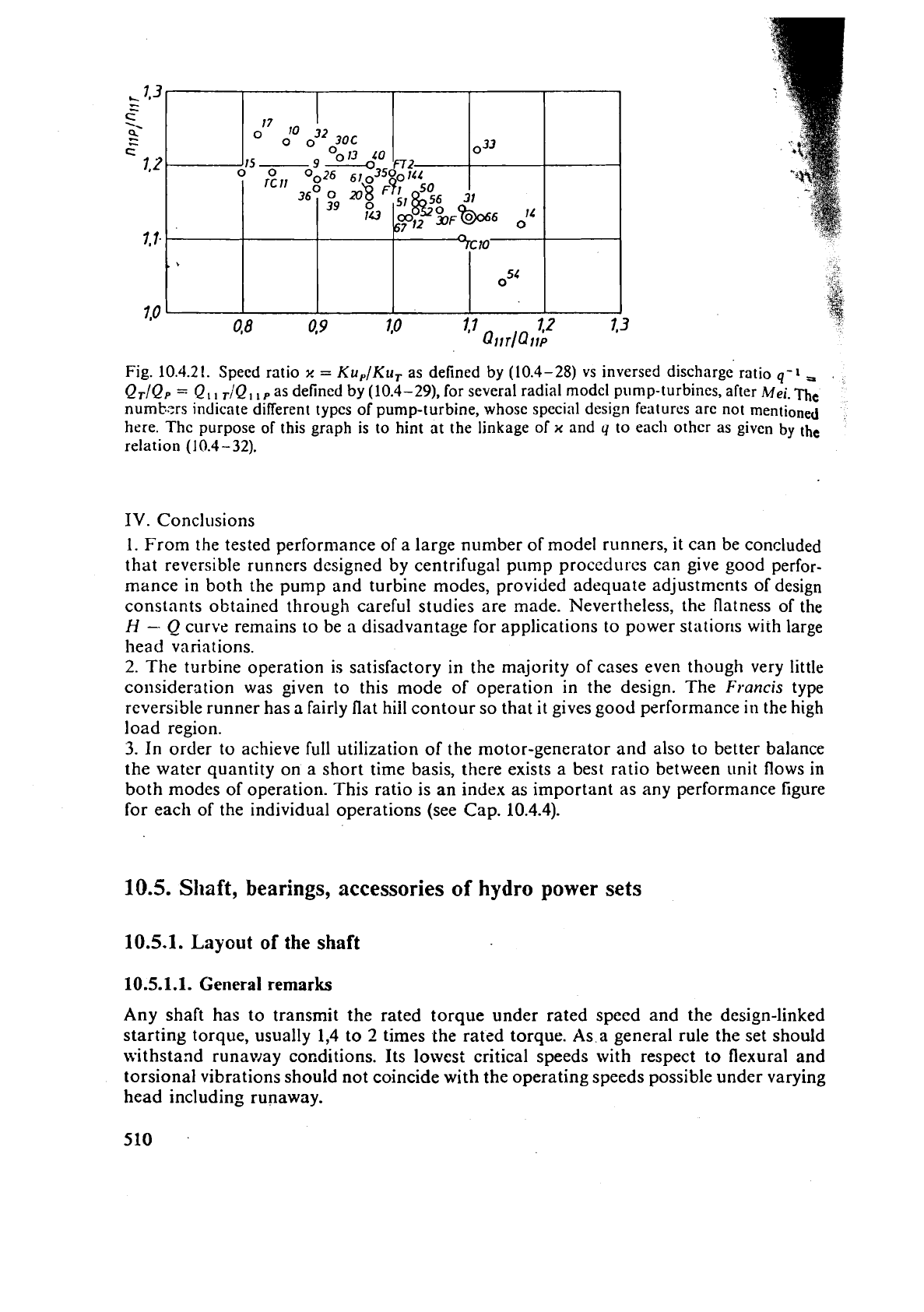
Fig. 10.4.21. Speed ratio
x
=
Ku,/Ku,
as defined by (10.4-28) vs invcrsed discharge ratio
q-l
,
.
Qr/Qp
--
QI
T/QI1
as defined by (10.4-29), for several radial model pump-turbines, after
Mei.
The
nurnb.:rs indicate different types of pump-turbine, whose special design features are
not
mentioned
here.
The
purpose
of
this graph is to hint at the linkage of
x
and
y
to each other as given by the
relation (10.4-32).
IV.
Conclusions
1. From the tested performance of a large number of model runners,
it
can be concluded
that reversible runners designed by centrifugal pump procedures can give good perfor-
mance in both the pump and turbine modes, provided adequate adjustments
of
design
constants obtained through careful studies are made. Nevertheless,
the flatness of the
H
-
Q
curve remains to be a disadvantage for applications to power statior~s with large
head variations.
2.
The turbine operation is satisfactory in the majority of cases even though very little
consideration was given to this mode of operation in the design. The
Francis
type
reversible runner has
a
fairly flat hiil contour so that it gives good performance in the high
load region.
3.
In order to achieve full utilization of the motor-generator and also to better balance
the water quantity on a short time basis, there exists a best ratio between unit flows in
both modes of operation. This ratio is an index as important as any performance figure
for each of the individual operations (see Cap.
10.4.4).
10.5.
Shaft,
bearings, accessories
of
hydro power sets
10.5.1.
Layout
of
the
shaft
10.5.1
.l.
General
remarks
Any shaft has to transmit the rated torque under rated specd and the design-linked
starting torque, usually 1,4 to
2
times the rated torque. As a general rule the set should
withstand
r~na\~~ay cocditions. Its lowest critical speeds with respect to flexural and
torsional vibrations should not coincide with the operating speeds possible under varying
head including runaway.
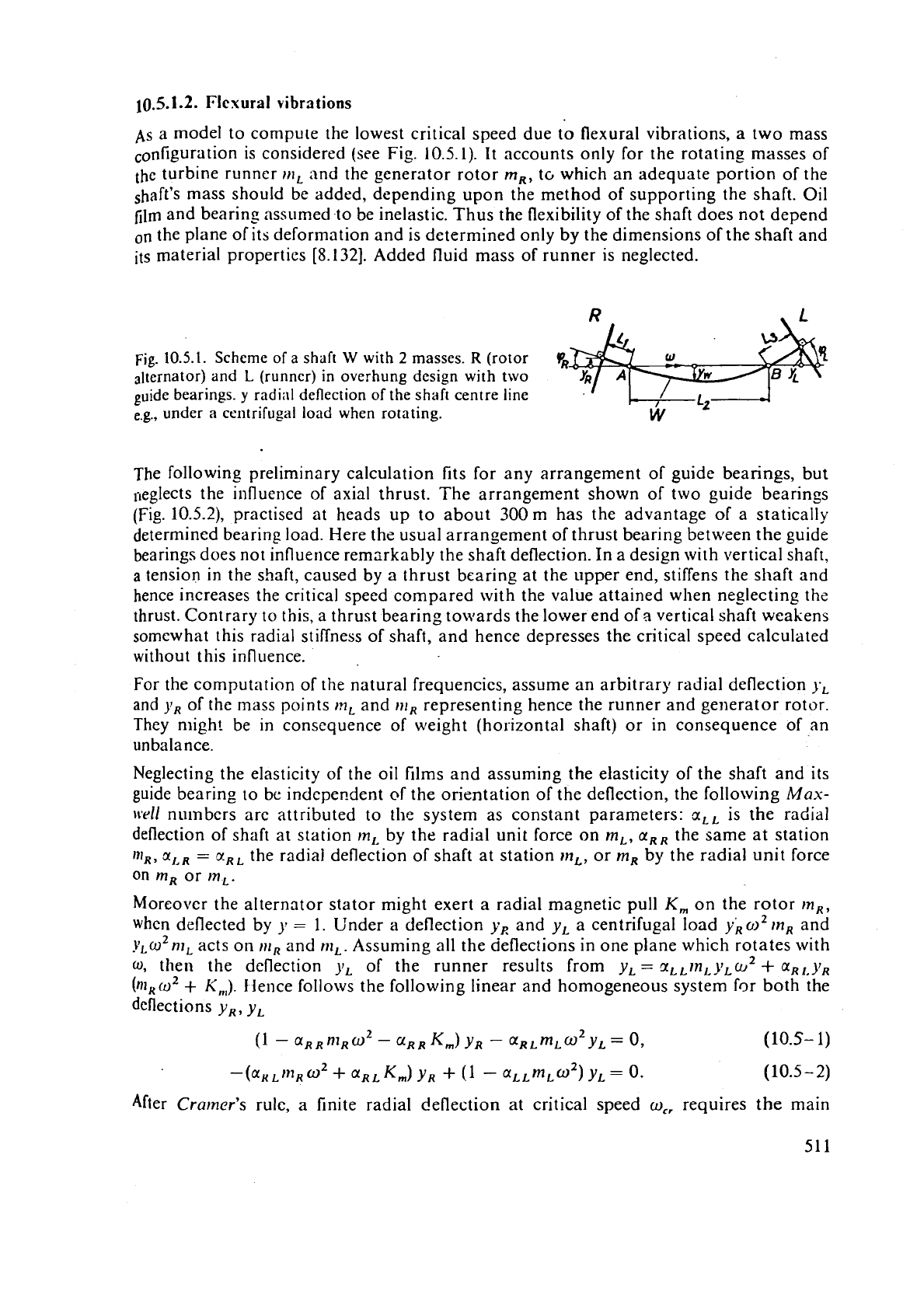
10.5.1.2.
Flexural vibrations
AS
a model to compute the lowest critical speed due to flexural vibrations, a two mass
configuration is considered (see Fig. 10.5.1). It accounts only for the rotating masses of
the turbine runner
111,
and the generator rotor m,,
t~
which an adequate portion of the
shaft's mass should be added, depending upon the method
of
supporting the shaft. Oil
film
and bearing assumed to be inelastic. Thus the flexibility of the shaft does not depend
on
the plane of its deformation and is determined only by the dimensions of the shaft and
its material properties [8.132]. Added fluid mass of runner is neglected.
Fig.
10.5.1.
Scheme of
a
shaft
W
with
2
masses.
R
(rotor
and
L
(runner) in overhung design with
two
bearings.
y
radial deflection of the shaft centre line
e.g.,
under
a
centrifugal load when rotating.
'
&L~-
W
The following preliminary calculation fits for any arrangement of guide bearings, but
fieglects the influence of axial thrust. The arrangement shown of two guide bearings
(Fig.
10.5.2), practised at heads up to about 300 m has the advantage
of
a statically
determined bearing load. Here the usual arrangement of thrust bearing between the guide
bearings does not influence
rem~rkably the shaft deflection. In a design with vertical shaft,
a
tension in the shaft, caused by a thrust bearing at the upper end, stiffens the shaft and
hence increases the critical speed compared with the value attained when neglecting
thz
thrust. Contrary to this, a thrust bearing towards the lower end of
a
vertical shaft weakens
somewhat this radial stiffness of shaft, and hence depresses the critical speed calculated
without this influence.
For the computation of the natural frequencies, assume an arbitrary radial deflection
J,
and
)I,
of the mass points
m,
and
111,
representing hence the runner and generator rotor.
They
nligh! be in consequence of weight (horizontal shaft) or in consequence of an
unbalance.
Neglecting the elasticity of the oil films and assuming the elasticity of the shaft and its
guide bearing to be independent of the orientation of the deflection, the following
Mas-
xull
numbers arc attributed to the system as constant parameters:
sr,,
is the radial
deflection of shaft at station
m,
by the radial unit force on m,,
a,,
the same at station
))IR,
aLR
=
gRL
the radial deflection of shaft at station
m,,
or m, by the radial unit force
On
m,
or
m,.
Moreover the alternator stator might exert a radial magnetic pull
K,
on the rotor
In,,
when deflected by
y
=
1.
Under a deflection
y,
and
y,
a centrifugal load
yko2mR
and
.~,cu~nl,
acts on
n~,
and
nr,.
Assuming all the deflections in one plane which rotates with
o,
then the deflection
y,
of the runner results from y,
=
rrLLrn,yLo12
+
a,,y,
(n1,s2
+
I(,,).
Ilence follows the following linear and homogeneous system f~r both the
deflections
y,,
y,
After Cramer's rule, a finite radial deflection at critical speed
o,,
requires the main
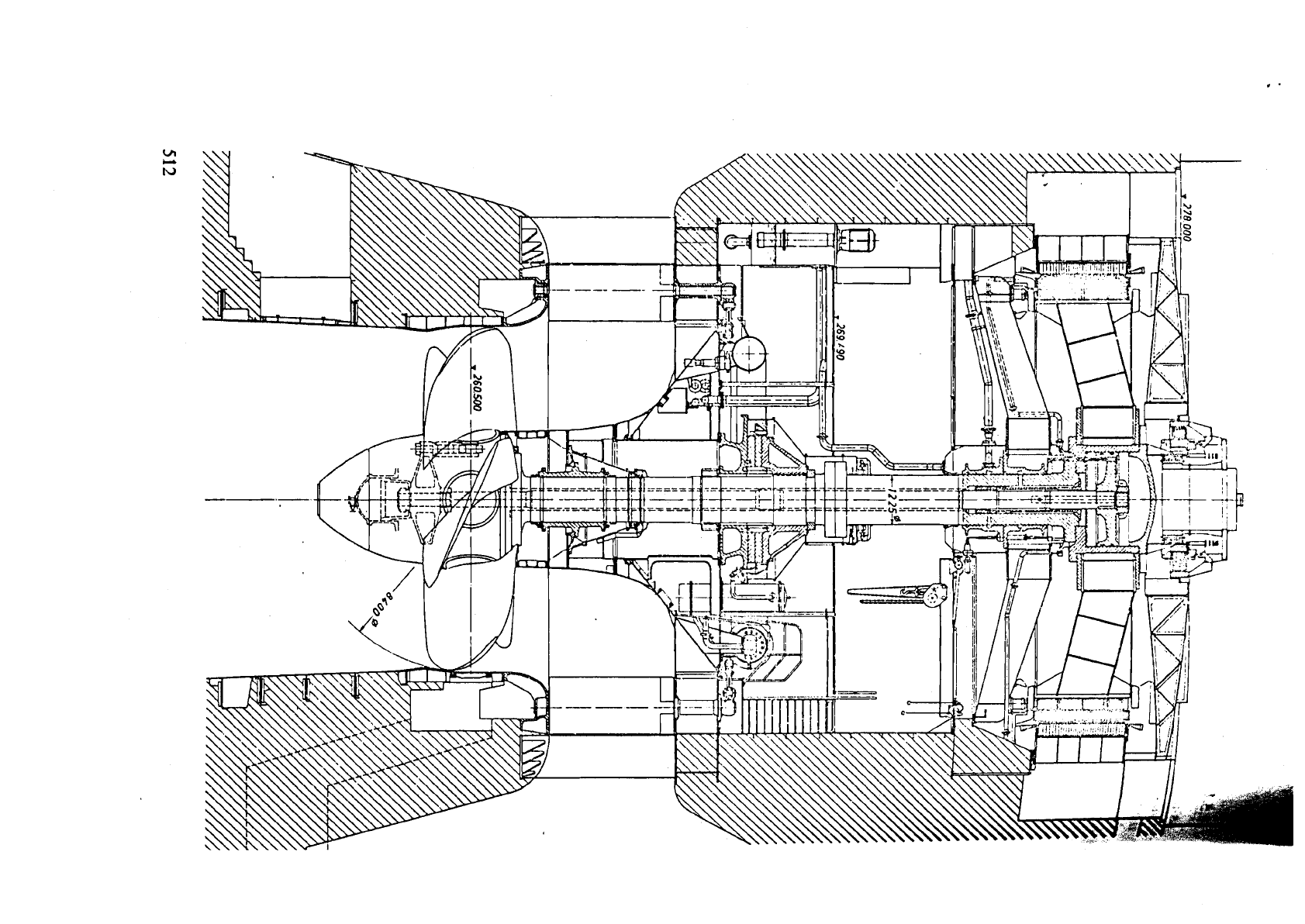
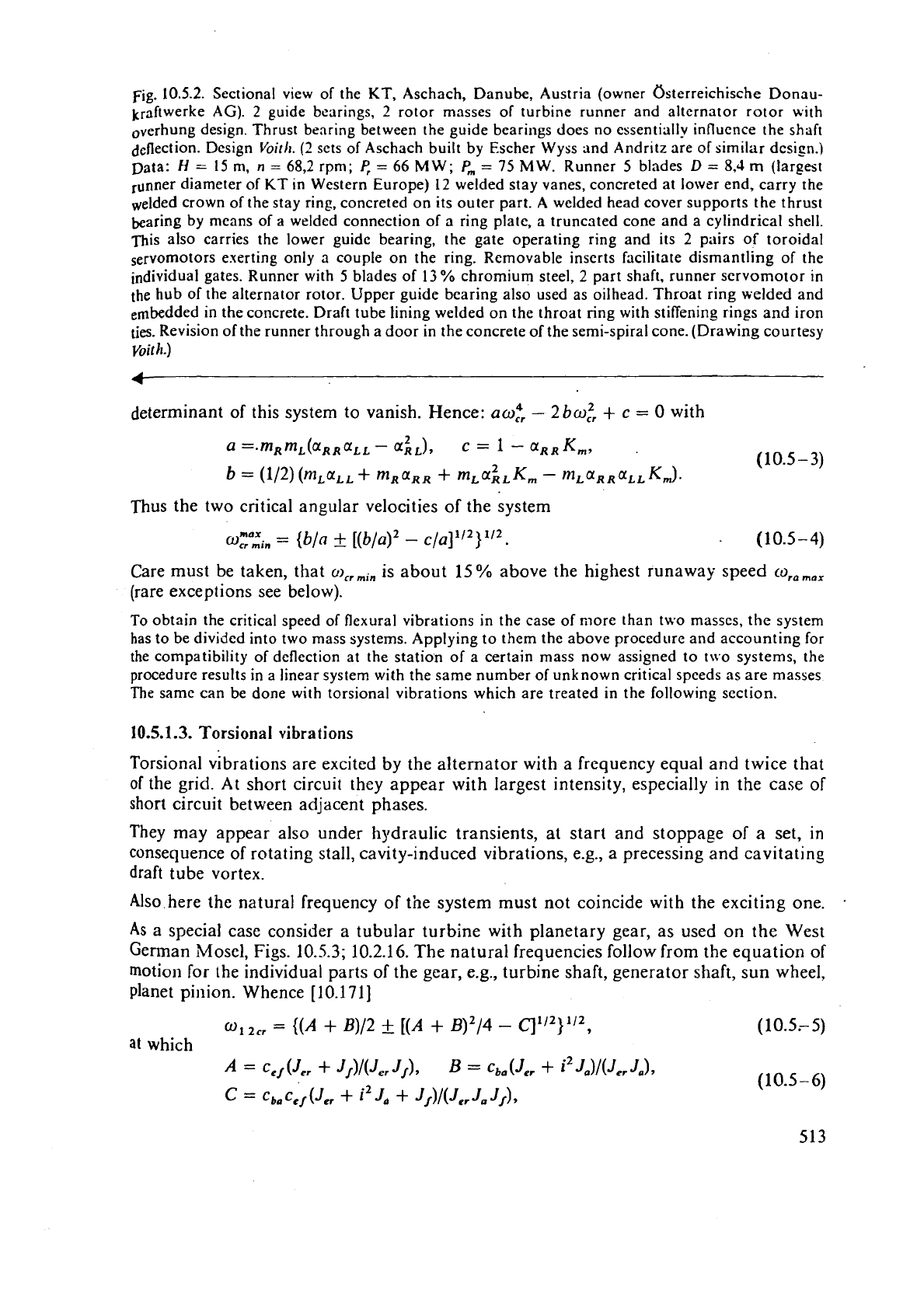
Fig.
10.5.2.
Sectional view of the KT, Aschach, Danube, Austria (owner 6sterreichische Donau-
kraftwerke
AG).
2
guide bearings,
2
rotor masses of turbine runner and alternator rotor with
design. Thrust
bearing between the guide bearings does no essentially influence the shaft
deflection. Design
Voith.
(2
sets of Aschach built by Escher Wyss and Andr~tz are of similar design.)
Data:
H
=
15
rn,
n
=
68,2
rpm;
P,
=
66
MW;
P,
=
75
MW.
Runner
5
blades
D
=
8,4
m
(largest
runner diameter of KT in Western Europe)
12
welded stay vanes, concreted at lower end, carry the
welded crown of the stay ring, concreted on its outer part. A welded head cover supports the thrust
bearing by means of a welded connection of
a
ring plate, a truncated cone and
a
cylindrical shell.
This also carries the lower guide bearing, the gate operating ring and its
2
pairs of toroidal
servomotors exerting only a couple on the ring. Removable inserts facilitate dismantling of the
individual gates. Runner with
5
blades of
13
%
chromium steel,
2
part shaft, runner servomotor
in
the
hub
of the alternator rotor. Upper guide bearing also used as oilhead. Throat ring welded and
embedded in the concrete. Draft tube lining welded on the throat ring with stiffening rings and iron
ties. Revision of the runner through
a
door in the concrete
of
the semi-spiral cone. (Drawing courtesy
Voitk.)
determinant of this system to vanish. Hence:
ao:
-
2bwfr
+
c
=
0
with
2
a=.mRmL(aRRaLL-a,,), c=1-u,,K,,
(10.5-3)
b=
(1/2)(m,a,,+m,a,.
+
m,a;,K,-m,~,R~,,KJ.
Thus the two critical angular velocities of the system
Care must be taken, that
o,,,i,,
is about
15
%
above the highest runaway speed
cora,,,
(rare exceptions see below).
To obtain the critical speed of flexural vibrations in the case of more than two masses, the system
has to be divided into two mass systems. Applying to them the above procedure and accounting for
the compatibility of deflection at the station of a certain mass now assigned to
two systems, the
procedure results in a linear system with the same number of unknown critical speeds as are masses
The same can be done with torsional vibrations which are treated in the following section.
10.5.1.3.
Torsional vibrations
Torsional vibrations are excited by the alternator with
a
frequency equal and twice that
of the grid. At short circuit they appear with largest intensity, especially in the case of
short circuit between adjacent phases.
They may appear also under hydraulic transients, at start and stoppage of
a
set, in
consequence of rotating stall, cavity-induced vibrations,
e.g., a precessing and cavitating
draft tube vortex.
Also here the natural frequency of the system must not coincide with the exciting one.
.
As
a special case consider a tubular turbine with planetary gear, as used on the West
German
Mosel, Figs.
10.5.3; 10.2.16.
The natural frequencies follow from the equation of
motion for the individual parts of the gear,
e.g., turbine shaft, generator shaft, sun wheel,
planet pinion. Whence
[10.17
11
112
112
01
2,,
=
{(A
+
B)/2
+
[(A
+
BI2/4
-
CI
1
,
(10.5.- 5)
at
which
A=ce~(Jer+J/)/(JerJ~),
B=cba(Jer+i2Ja)I(JerJa),
(10.5-6)
c
=
cba
ce,
(Jer
+
i2
Jd
+
J,)/(
J,,
J,
J,)
9
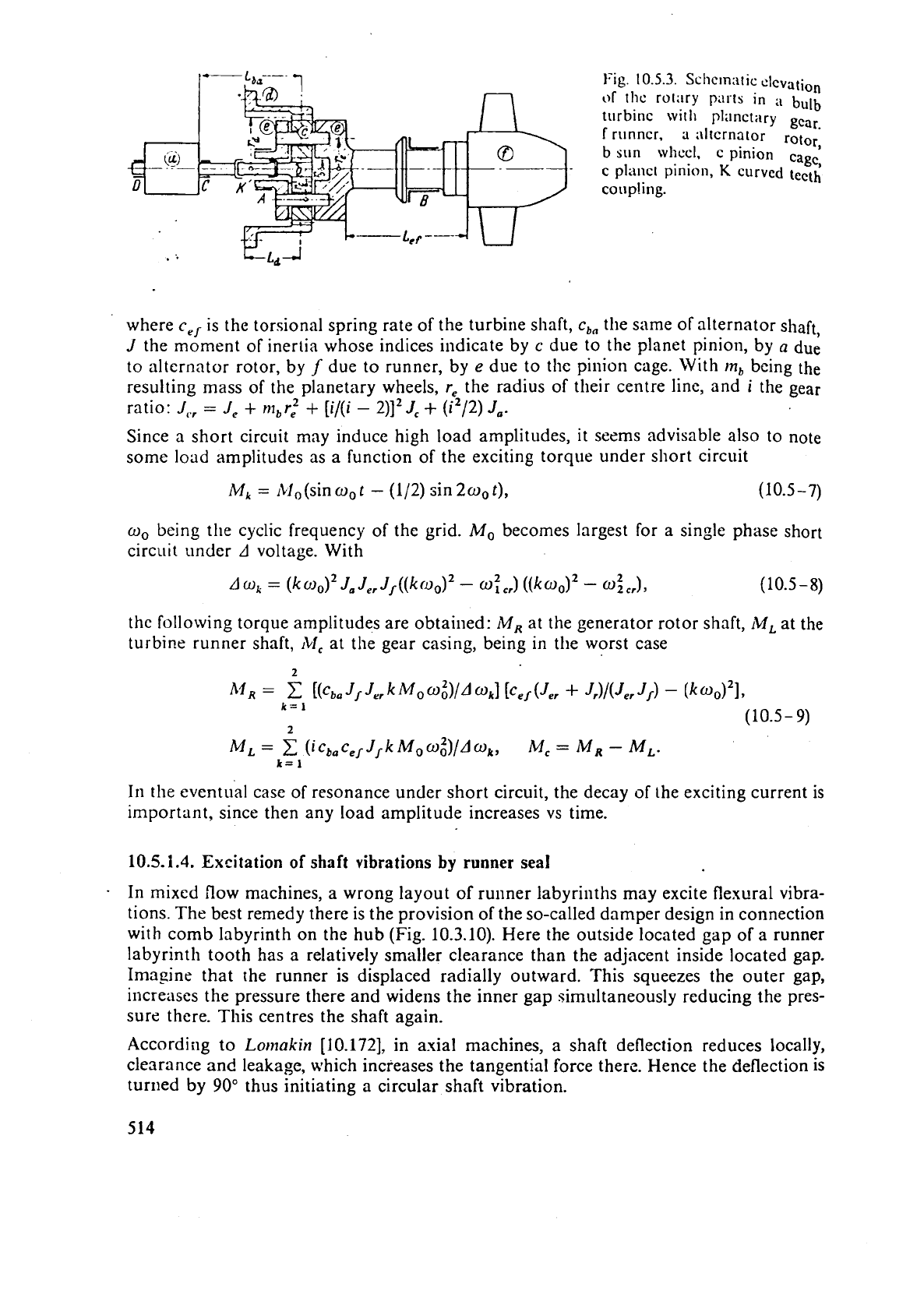
I-ig.
10.5.3.
Schc~nstic
cIc~~(~~~
of
thc
rolary
parts
in
;I
bulb
turbine
with
plancti~ry
gcnr.
f
runner,
a
illlcrnnlor rotor,
b
sun
wllccl,
e
pinion cage,
c
pl;l~nct
pinion,
K
curved
teeth
coap!ing.
where
cef
is the torsional spring rate of the turbine shaft,
c,,
tlle same of alternator shaft,
J
the moment of inertia whose indices indicate by
c
due to the planet pinion, by
a
due
to alternator rotor,
by
f
due to runner, by
e
due to the pinion cage. With
lnb
being the
resulting mass of the planetary wheels,
re
the radius of their centre line, and
i
the gear
ratio:
J,.,
=
J,
+
tn,r;
+
[i/(i
-
2)12
Jc
+
(i2/2)
Ja.
Since a short circuit may induce high load amplitudes, it seems advisable also to note
some load amplitudes as a function of the exciting torque under short circuit
M,
=
iLl,(sin
o,
t
-
(112) sin 20,
t),
(10.5-7)
oo
being tl~e cyclic frequency of the grid.
M,
becomes largest for a single phase short
circuit under
A
voltage. With
thc following torque amplitudes are obtained:
M,
at the generator rotor shaft,
iM,
at the
turbine runner shaft,
1LiC
at the gear casing, being in the worst case
In the eventual case of resonance under short circuit, the decay of the exciting current is
important, since then any load amplitude increases vs time.
10.5.1.4.
Excitation of
shaft
vibrations
by
runner seal
In mixed flow machines, a wrong layout of runner labyrinths may excite flexural vibra-
tions. The best remedy there is the provision of the so-called damper design in connection
with comb labyrinth on the hub (Fig. 10.3.10). Here the outside located gap of a runner
labyrinth tooth has a relatively smaller clearance than the adjacent inside located gap.
Imagine that the runner
is
displaced radially outward. This squeezes the outer gap,
increases the pressure there and widens the inner gap simultaneously reducing the pres-
sure there. This centres the shaft again.
According to
Lomakin
[10.172], in axial machines, a shaft deflection reduces locally,
clearance and leakage: which increases the tangential force
therc. Hence the deflection is
turned by
90"
thus ln~tiating a circular
shaft
vibration.
